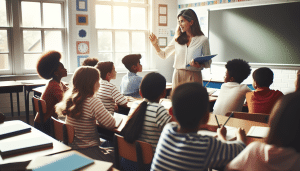You Find Surprising Benefits of Bilingual Education
Oliver Cooper September 28, 2025
Explore the multifaceted impact of bilingual education across academic performance, cognitive growth, social mobility, and global opportunities. This guide breaks down surprising advantages and potential challenges, offering insights for families, educators, and lifelong learners alike.
The Rise of Bilingual Education in Schools
Bilingual education continues to grow in popularity, shifting how students and educators view language learning. Many schools now recognize that integrating programs in both native and second languages does more than boost basic competency—it cultivates a deeper understanding of culture and communication. Through well-structured classroom immersion and dual language programs, learners acquire key academic foundations while gaining real-world language proficiency.
This educational shift comes as families consider future global opportunities for their children. Parents and policymakers note that the demand for cross-linguistic skills increases each year. Bilingual instruction is prevalent in regions with diverse communities and has been linked to higher retention rates, positive identity development, and stronger school engagement.
The journey toward establishing a successful bilingual curriculum involves addressing challenges such as resource allocation and teacher training. Still, more schools are implementing dual language pathways. This approach is helping to close achievement gaps, particularly for English learners, by supporting both language development and academic growth simultaneously.
Cognitive Advantages of Learning in Two Languages
Research on bilingual education reveals surprising cognitive benefits that extend far beyond language proficiency. Students who engage with coursework in two languages often demonstrate enhanced executive function, including memory, problem-solving, and multitasking. These skills are not only beneficial inside the classroom but translate into daily life advantages.
The act of switching between languages sharpens attention and increases mental flexibility. Bilingual learners develop the ability to filter distractions, focusing on relevant information more effectively than their monolingual peers. According to cognitive scientists, this kind of mental training shapes brain structure, promoting lifelong cognitive health (https://www.apa.org/topics/bilingualism).
Some studies even indicate that bilingualism may contribute to delayed onset of age-related cognitive decline, including conditions like dementia. Early language immersion has been linked to improved test scores in math and reading, suggesting that the advantages ripple throughout core academic areas, not just language arts.
Academic Performance and Language Programs
Many parents want to know if bilingual education gives children a measurable edge in school. Evidence shows that students in well-implemented programs achieve equal or better academic results compared to those in monolingual settings. Reading comprehension and critical thinking are notably improved for those immersed in two languages.
Bilingual schools often employ different instructional strategies tailored to diverse learning styles. These programs introduce complex concepts through two linguistic frameworks, strengthening concept retention and encouraging creative problem-solving. Assessments from multiple districts highlight improvements in graduation rates and college readiness among bilingual graduates (https://educationnorthwest.org/resources/bilingual-education).
Still, the effectiveness of a bilingual education often relies on access to qualified teachers and quality curricular materials. Areas where robust support exists tend to see the most dramatic gains. This underscores how investments in educational infrastructure play a key role in academic achievement for multilingual learners.
Social Mobility and Global Competence
The workplace is evolving, with cross-cultural communication and global awareness becoming vital job skills. Bilingual education readies students for this new landscape by cultivating both language and cultural competence. Understanding more than one language enables graduates to bridge communities and access wider career networks, an advantage especially strong in today’s interconnected world.
For many students, bilingualism leads to opportunities for study abroad, internships, and work placements requiring multilingual skills. Educational experts point out that the ability to negotiate, lead, and collaborate across diverse teams is increasingly valued in both public and private sectors. Language skills may open doors to roles in international business, healthcare, diplomacy, and education (https://www.actfl.org/advocacy/research/projects/the-language-advantage).
Research also reveals that bilingual programs nurture empathy, adaptability, and cross-cultural attitudes. These attributes underpin lifelong learning and leadership potential, suggesting social and economic ripple effects that extend to entire communities and societies.
Cultural Identity and Emotional Wellbeing
For students from immigrant or multilingual backgrounds, being able to learn in both their heritage language and the dominant societal language can be transformative. Bilingual education allows learners to maintain a sense of cultural identity while acquiring the skills needed to thrive academically and socially.
Cultural affirmation in school helps students build self-esteem, pride, and resilience. When families see their values reflected in classroom content, engagement rises. This connection between home and school fosters a sense of belonging, which correlates closely with academic success and mental health (https://www.edutopia.org/article/why-language-matters-bilingual-education).
The emotional security provided by recognizing and respecting bilingual backgrounds cannot be underestimated. Social support networks are strengthened, and students become more open to collaboration and community involvement. Educators see this as a win-win for academic achievement and holistic development.
Navigating Challenges in Bilingual Education
While the positive outcomes of bilingual programs are clear, communities must tackle real hurdles. Access to experienced bilingual teachers, differences in program models, and balancing two languages present ongoing challenges. Funding and professional development demand ongoing public investment to keep programs robust and effective.
Families may also face practical questions about language priorities at home. Schools respond by equipping parents with resources and workshops, guiding them through the benefits of maintaining a multilingual environment. Research shows that strong home-school partnerships are a foundation for bilingual learner success (https://www.colorincolorado.org/article/parents-guide-bilingual-education).
Ultimately, the path towards effective bilingual education involves community buy-in, ongoing evaluation, and flexible curriculum design. When these are in place, bilingual programs become a cornerstone of educational equity and opportunity for every student.
References
1. American Psychological Association. (n.d.). Bilingualism. Retrieved from https://www.apa.org/topics/bilingualism
2. Education Northwest. (2021). The importance of bilingual education. Retrieved from https://educationnorthwest.org/resources/bilingual-education
3. ACTFL. (n.d.). The language advantage. Retrieved from https://www.actfl.org/advocacy/research/projects/the-language-advantage
4. Edutopia. (2023). Why language matters in bilingual education. Retrieved from https://www.edutopia.org/article/why-language-matters-bilingual-education
5. Colorín Colorado. (2022). A parent’s guide to bilingual education. Retrieved from https://www.colorincolorado.org/article/parents-guide-bilingual-education
6. UNESCO. (n.d.). Bilingual and multilingual education. Retrieved from https://www.unesco.org/en/education/bilingual-education







